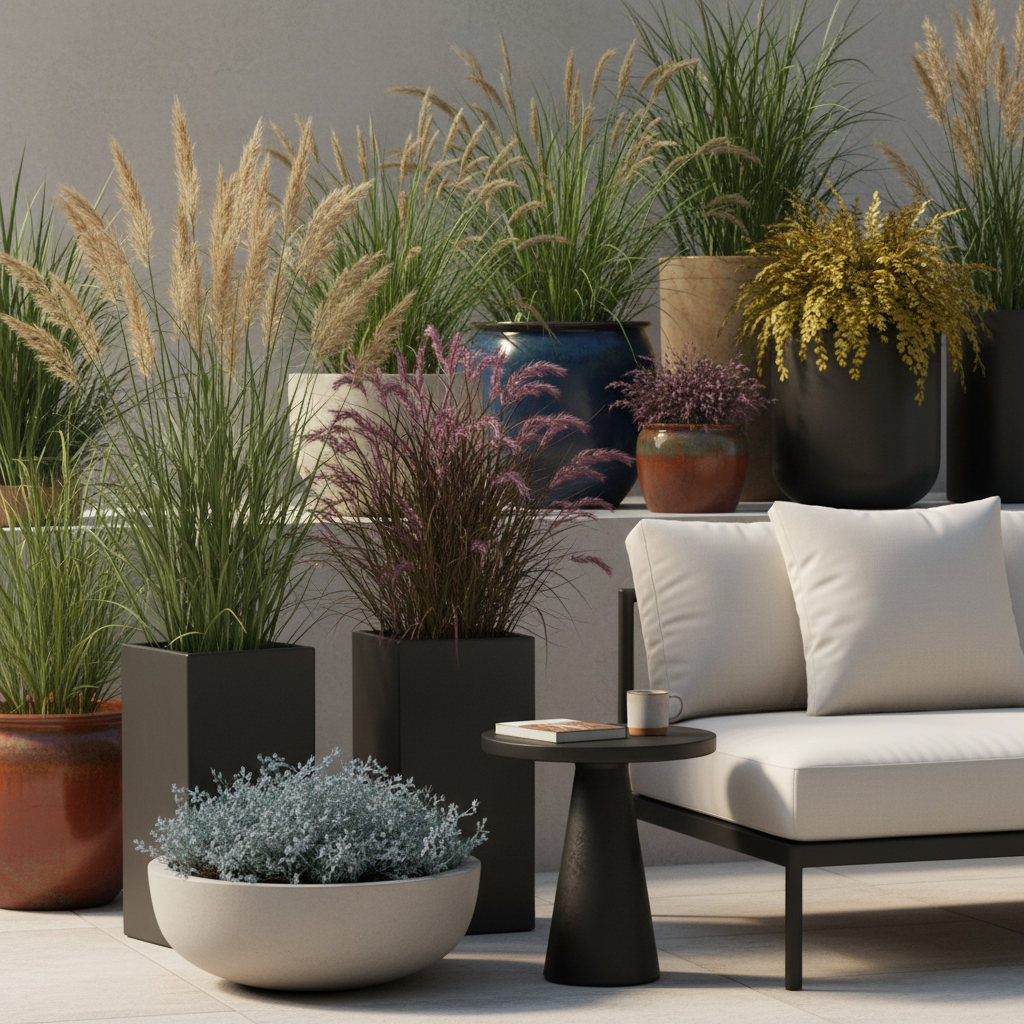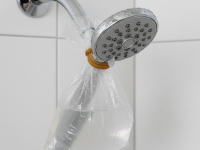Imagine stepping onto your patio, a serene extension of your home, adorned with graceful textures, subtle movements, and vibrant hues that shift with the breeze. If you’re seeking to transform your outdoor living space into a stylish, low-maintenance haven, you’ve landed in the perfect spot. Today, we’re diving deep into the art of how to decorate a patio using potted ornamental grass – a versatile and elegant solution that brings architectural interest, soft natural beauty, and a touch of modern sophistication to any outdoor setting.
Potted ornamental grasses offer an incredible array of benefits, from their striking visual appeal to their surprising resilience and ease of care. They can serve as dynamic focal points, gentle privacy screens, or simply add a whisper of nature to your urban balcony or spacious backyard patio. Whether you’re a seasoned gardener or just starting your green-thumb journey, integrating these beautiful plants into your patio decor is an achievable and rewarding endeavor. This comprehensive guide will walk you through everything you need to know, ensuring your patio becomes the envy of the neighborhood.
Why Choose Ornamental Grasses for Your Patio?
Before we delve into the specifics of how to decorate a patio using potted ornamental grass, let’s explore why these plants are such a fantastic choice for container gardening and outdoor decor. Their unique characteristics make them stand out from traditional potted plants, offering a refreshing alternative.
- Unparalleled Texture and Movement: Ornamental grasses introduce an element of dynamic texture that few other plants can match. Their delicate blades sway gracefully in the wind, creating a mesmerizing dance that adds a sense of calm and natural rhythm to your patio. This movement softens hardscape edges and brings life to static spaces.
- Low Maintenance and Drought Tolerance: Many ornamental grasses are incredibly resilient. Once established, they often require less water than flowering plants, making them ideal for busy homeowners or those in drier climates. They’re generally pest-resistant and don’t demand constant deadheading or pruning, making them a true low-maintenance choice for decorating your patio.
- Year-Round Interest: While many plants offer seasonal beauty, numerous ornamental grasses provide multi-season appeal. Some boast vibrant green foliage in spring and summer, transitioning to stuing russets, golds, or purples in fall. Varieties like feather reed grass (Calamagrostis acutiflora ‘Karl Foerster’) even offer beautiful seed heads that persist through winter, adding structure and visual appeal when other plants have faded.
- Modern Aesthetic and Versatility: Ornamental grasses lend themselves beautifully to a range of design styles, from minimalist and contemporary to rustic and naturalistic. Their clean lines and natural forms complement modern architecture, while their organic feel softens industrial elements. They can be used to create dramatic statements or subtle accents, making them incredibly versatile when considering how to decorate a patio using potted ornamental grass.
- Privacy and Screening: Taller varieties of ornamental grasses, when planted in large pots, can serve as fantastic living screens. They offer a soft, permeable barrier that provides privacy without feeling imposing or blocking all light and breeze. This is particularly useful for urban patios or shared outdoor spaces.
Choosing the Perfect Grasses for Your Pots
The success of your patio decor begins with selecting the right plants. Not all ornamental grasses are created equal, especially when it comes to container living. Consider these factors when making your selections, thinking specifically about your goal of how to decorate a patio using potted ornamental grass.
Consider Your Climate and Sun Exposure
Before you fall in love with a particular grass, check its hardiness zone and sun requirements. Most ornamental grasses thrive in full sun (at least six hours of direct sunlight daily), but some prefer partial shade. Match the grass to your patio’s specific conditions to ensure its health and vitality.
Size and Growth Habit Matter
When selecting grasses for pots, remember that their mature size in a container will likely be slightly smaller than if planted directly in the ground, but they still need room to grow. Consider the overall scale of your patio and the pots you’ll be using. Grasses generally fall into a few categories:
- Upright/Vertical: These grasses grow tall and narrow, perfect for creating height, accentuating architectural features, or forming privacy screens. Examples include ‘Karl Foerster’ feather reed grass and certain varieties of switchgrass (Panicum virgatum).
- Mounding: These varieties form neat, rounded clumps, ideal for softening edges, filling space, and providing a lush, full look. Blue fescue (Festuca glauca) and many types of sedge (Carex) are good examples.
- Cascading/Spreading: While less common for containers, some grasses have a weeping or trailing habit, adding a graceful spill over the edge of a pot. This can create a beautiful contrast with more upright plants.
Popular Potted Ornamental Grasses for Patio Decorating
Here are some excellent choices known for their performance in containers:
- Fountain Grass (Peisetum alopecuroides): A classic for a reason! Its soft, arching foliage and fluffy, bottlebrush-like plumes are incredibly charming. Many cultivars are available, offering different sizes and bloom colors.
- Maiden Grass (Miscanthus sinensis): Taller varieties of Maiden grass can create a dramatic statement or privacy screen. Look for cultivars like ‘Morning Light’ with its variegated foliage or ‘Little Zebra’ for unique striped blades.
- Blue Fescue (Festuca glauca): A compact, mounding grass known for its striking icy blue foliage. Perfect for adding a cool color accent and fine texture to smaller pots or the front of a grouping.
- Japanese Forest Grass (Hakonechloa macra): This beautiful, cascading grass is ideal for shade or part shade. Its bright green or variegated foliage creates a lush, flowing effect, excellent for softening harsh edges.
- Purple Fountain Grass (Peisetum setaceum ‘Rubrum’): A stuing aual in most northern climates, this grass features rich burgundy foliage and fluffy purple plumes, making a bold statement.
- Switchgrass (Panicum virgatum): Native and tough, many switchgrass cultivars offer beautiful upright forms, often with reddish or purplish tints and airy seed heads.
Selecting the Right Containers for Your Grasses
The pot you choose is just as important as the grass itself when considering how to decorate a patio using potted ornamental grass. The container contributes significantly to the overall aesthetic and the plant’s health.
Size Matters for Growth
Always choose a pot that is large enough to accommodate the mature root ball of your chosen grass, with some room to grow. A general rule of thumb is to select a pot that is at least 12-18 inches in diameter for most medium-sized grasses. Taller varieties will require even larger, heavier pots to prevent them from toppling over in windy conditions.
Drainage is Non-Negotiable
All containers MUST have drainage holes at the bottom. Ornamental grasses, like most plants, do not tolerate sitting in soggy soil, which can lead to root rot. If your chosen pot lacks drainage, drill holes yourself or select another option.
Material and Style
The material and style of your pots should complement your patio’s existing decor and the aesthetic you’re aiming for. Remember that the container is part of your overall design when you think about how to decorate a patio using potted ornamental grass.
- Terra Cotta: Classic and breathable, but can dry out quickly. Best for traditional or Mediterranean styles.
- Ceramic/Glazed Pots: Offer a wide range of colors and finishes, allowing you to match or contrast with your grasses. They retain moisture well.
- Resin/Plastic: Lightweight, durable, and often more affordable. Excellent for large grasses where weight is a concern, or if you need to move pots frequently.
- Metal: Modern and industrial, but can heat up quickly in direct sun, potentially stressing roots.
- Concrete/Fiberglass: Heavy, sturdy, and create a sophisticated, modern look. Ideal for large, permanent installations.
Think about the color and texture of the pot. A dark, sleek container can highlight bright green foliage, while an earthy, textured pot might enhance the natural feel of a rustic patio.
Mastering the Art of Potting Ornamental Grass
Once you’ve chosen your grasses and pots, it’s time to get your hands dirty! Proper potting techniques ensure your grasses get off to the best possible start.
The Right Soil Mix
Use a high-quality potting mix designed for containers. This mix should be well-draining yet retain enough moisture. Avoid using garden soil, as it compacts in pots and doesn’t drain efficiently. You can amend your potting mix with a little compost for added nutrients, but generally, a good quality commercial mix is sufficient.
Planting Steps
- Prepare the Pot: Ensure your pot has drainage holes. You can place a piece of screening or a coffee filter over the holes to prevent soil from escaping while still allowing water to drain.
- Add Soil: Fill the bottom of the pot with enough potting mix so that when you place the grass in, the top of its root ball is about 1-2 inches below the rim of the pot.
- Remove from Nursery Pot: Gently remove the grass from its nursery container. If the roots are tightly bound (root-bound), gently loosen them with your fingers, especially around the bottom.
- Position the Grass: Place the grass in the center of the pot. The crown of the plant (where the stems meet the roots) should be level with or slightly above the surrounding soil, not buried.
- Fill with Soil: Backfill around the root ball with potting mix, gently tamping it down to remove large air pockets. Leave about 1 inch of space between the soil surface and the rim of the pot to allow for watering without overflow.
- Water Thoroughly: Water your newly potted grass generously until water drains from the bottom of the pot. This helps settle the soil and hydrate the plant.
How to Decorate a Patio Using Potted Ornamental Grass: Design Principles
Now for the fun part – arranging your beautiful potted grasses to create a stuing outdoor display! Understanding some basic design principles will help you maximize their impact and achieve a cohesive, inviting look. This is where your personal style truly shines when considering how to decorate a patio using potted ornamental grass.
Grouping and Layering for Visual Depth
Avoid scattering individual pots haphazardly. Instead, group them in odd numbers (e.g., three or five) to create more dynamic arrangements. Vary the heights and textures within your groups. Place taller, upright grasses at the back or center, medium-sized mounding grasses in the middle, and smaller, cascading varieties at the front or edge of the grouping. This layering creates visual depth and interest, drawing the eye through the display. Imagine a tall Miscanthus flanked by two shorter Peisetums, with a low-growing Blue Fescue in front.
Creating Focal Points and Statements
A single, striking ornamental grass in a substantial, eye-catching pot can serve as a powerful focal point on your patio. Choose a grass with unique color, size, or plume characteristics, such as a large ‘Karl Foerster’ feather reed grass or a vibrant Purple Fountain Grass. Position this statement piece where it can be admired from multiple angles, perhaps at the entrance to your patio or at a corner that draws the eye. This is a key strategy when thinking about how to decorate a patio using potted ornamental grass to maximum effect.
Defining Zones and Pathways
Potted ornamental grasses are excellent tools for defining different functional zones on a larger patio. Use a row of tall, narrow grasses in rectangular planters to delineate a dining area from a lounge space. A pair of identical potted grasses can elegantly frame an entryway or passage, inviting guests to move from one area to another. This creates a sense of structure and flow in your outdoor living area, transforming an open slab into distinct, purposeful spaces.
Achieving Privacy and Screening
As mentioned, taller grasses can provide a natural screen. Place several large pots of upright grasses like Maiden grass or Switchgrass along a fence line, balcony railing, or around a seating area. They offer a soft, airy barrier that provides seclusion without blocking light completely. Unlike solid walls, the rustling of the leaves adds a soothing auditory element to your private oasis. This is a practical and beautiful way to address the question of how to decorate a patio using potted ornamental grass while also adding functionality.
Complementary Plantings and Companion Pots
While ornamental grasses are beautiful on their own, pairing them with other plants can elevate your patio decor. Consider the “thriller, filler, spiller” approach often used in container gardening. A tall grass can be the “thriller,” while mounding auals (like petunias or impatiens) or pereials (like Heuchera) act as “fillers.” Trailing plants (such as sweet potato vine or creeping jey) can be the “spillers” that cascade over the pot’s edge. This creates a full, lush, and multi-dimensional arrangement. For more inspiration on creative container combinations, check out reputable sources like Better Homes & Gardens, which offers a wealth of ideas for integrating various plants into your patio designs. Better Homes & Gardens provides excellent guidance on mixing and matching for stuing results.
Lighting Accents for Evening Ambiance
Don’t forget about how your patio looks after sunset! Strategically placed lighting can dramatically enhance the beauty of your potted ornamental grasses. Up-lighting from small spotlights placed at the base of a pot can highlight the unique texture and movement of the grass blades, casting captivating shadows. String lights or lanterns nearby can create a warm, inviting glow that makes your patio feel magical. The interplay of light and shadow on the swaying grasses adds a truly enchanting dimension to your evening outdoor experience.
Seasonal Transitions and Year-Round Interest
Many ornamental grasses offer fantastic fall and winter interest. Allow their seed heads to remain through the colder months, providing architectural structure and food for birds. If your grasses are auals in your climate, plan for seasonal change-outs. If they are pereials, consider adding seasonal companion plants (e.g., spring bulbs, fall mums) around their base in the pots to ensure continuous visual appeal. This thoughtful approach keeps your patio vibrant and engaging throughout the year.
Caring for Your Potted Ornamental Grasses
Even though they are generally low-maintenance, potted ornamental grasses do have specific needs to keep them looking their best. Understanding these care requirements is essential for long-term success when you learn how to decorate a patio using potted ornamental grass.
Watering Wisely
Potted plants dry out more quickly than those in the ground. While ornamental grasses are often drought-tolerant, they still need consistent moisture in containers. Check the soil moisture daily, especially during hot, windy weather. Water deeply until you see water draining from the bottom. Allow the top inch or two of soil to dry out between waterings. Overwatering is a common killer of potted plants, so err on the side of slightly dry rather than constantly soggy.
Fertilizing for Growth
Ornamental grasses are not heavy feeders. A slow-release granular fertilizer applied in spring, or a diluted liquid fertilizer every few weeks during the growing season, is usually sufficient. Avoid over-fertilizing, which can lead to excessive, floppy growth rather than strong, upright forms.
Pruning and Maintenance
Most deciduous ornamental grasses (those that turn brown in winter) should be cut back hard in late winter or early spring, just before new growth emerges. Cut them back to about 4-6 inches from the ground. Evergreen grasses (like some sedges) generally only need old or damaged foliage removed. Regularly inspect your grasses for yellowing leaves or spent flower stalks, and trim them as needed to maintain a tidy appearance.
Overwintering Strategies (for Pereial Grasses)
If you live in a climate colder than the grass’s hardiness zone, you’ll need to protect pereial grasses during winter. For many grasses, you can move the pots into an unheated garage, shed, or basement once temperatures consistently drop below freezing. Reduce watering significantly during this dormant period. Another option is to insulate the pots outdoors by wrapping them in burlap or bubble wrap, or placing them together in a sheltered spot and mounding mulch around them. This helps prevent the roots from freezing solid.
Common Challenges and Troubleshooting
Even with the best intentions, you might encounter a few hiccups. Knowing how to troubleshoot can save your plants and keep your patio looking fabulous.
- Browning Leaf Tips: Often a sign of inconsistent watering (too dry, then too wet) or nutrient deficiency. Check your watering schedule and consider a light feeding.
- Floppy Growth: Can be caused by too much fertilizer, not enough sun, or simply choosing a variety that is too large for its pot or tends to flop naturally. Reduce feeding, move to a suier spot, or consider a more compact cultivar next season.
- Pests: Ornamental grasses are generally pest-resistant, but occasionally aphids or spider mites can appear. A strong spray of water or an insecticidal soap can usually handle minor infestations.
- Lack of Blooms/Seed Heads: Most commonly due to insufficient sunlight. Ensure your grass is getting enough direct sun for its species.
Your Beautiful Patio Awaits!
Decorating your patio using potted ornamental grass is an incredibly rewarding endeavor that offers endless possibilities for creativity and personal expression. From the subtle rustle of their blades in the breeze to their striking architectural forms and changing seasonal colors, these versatile plants bring a unique blend of elegance, movement, and tranquility to any outdoor space.
By carefully selecting the right varieties, choosing appropriate containers, and applying thoughtful design principles, you can transform your patio into a sophisticated and inviting oasis. Remember that the journey of how to decorate a patio using potted ornamental grass is an enjoyable one – experiment with different arrangements, observe how the light plays on your grasses throughout the day, and revel in the natural beauty you’ve cultivated. Go ahead, embrace the grace of ornamental grasses, and watch your patio come alive!




